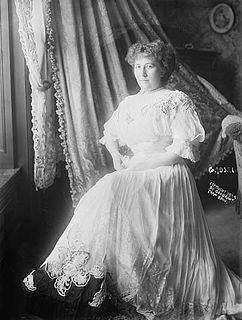
Luisa Tetrazzini was an Italian coloratura soprano of great international fame. Tetrazzini “had a scintillating voice with a brilliant timbre and a range and agility well beyond the norm...” She enjoyed a highly successful operatic and concert career in Europe and America from the 1890s through to the 1920s. Her voice lives on in recordings made from 1904-1920. She wrote a memoir, My Life of Song, in 1921 and a treatise, How to Sing, in 1923. After retirement, she taught voice in her homes in Milan and Rome until her death.

Johanna Emilia Agnes Gadski was a German soprano. She was blessed with a secure, powerful, ringing voice, fine musicianship and an excellent technique. These attributes enabled her to enjoy a highly successful career in New York City and London, performing heavy dramatic roles in the German and Italian repertoires.

Jenny Dufau was a French opera singer who found her success in Chicago.
Carlo Peroni was an Italian opera conductor who served as the musical director of Fortune Gallo's San Carlo Opera Company (SCOC) from 1921 until his death 23 years later. With that company he performed in almost every major city in North America, typically conducting 8 opera performance a week eight months out of the year. In 1934, upon Peroni's 500th performance with the SCOC, The New York Times declared that he had conducted more grand opera performances in North America than any conductor in history.
Malvina Pereira was a Brazilian soprano. She is thought to be the first opera singer from Brazil to have had an international career.

Josephine Lucchese was an American operatic soprano who had an active international singing career during the 1920s and 1930s. A skilled coloratura soprano, she was particularly admired for her portrayals of Rosina in The Barber of Seville, Violetta in La traviata, and the title role in Lucia di Lammermoor. She began her opera career in 1920 with the San Carlo Opera Company; a touring opera company in the United States. She was a resident artist with the Philadelphia Grand Opera Company from 1929-1932, and was a principal artist with the Dutch National Opera during the 1930s. She also appeared as a guest artist with American and European opera houses during her career.

Ester Adaberto, born Ester Nunez de Arce, was an Italian opera singer.

Hilda Anthony, also seen as Hilda Antony, was a British actress born in Chile. She appeared in four silent films and many stage productions in London.

Regina Vicarino was an American soprano opera singer.

Clarita Vidal was an actress in Edwardian musical comedies, later known for her wartime work in Italy as Countess Chiquita Mazzuchi.

Ester Ferrabini was an Italian opera singer.

Dora de Phillippe, born Dora Auspitz, was a French soprano opera singer, based in North America, also known for her work in war relief during World War I.

Odette Le Fontenay, born Odette Le Flaguais, was a French soprano opera singer and music educator based in the United States after 1913. She sang with the Metropolitan Opera in its 1916-1917 season.

Ekaterina Galanta, often billed as Ketty Galanta, was a Russian dancer, a member of the Ballets Russes.

Rosa Olitzka was a German-born contralto singer. She sang with the Metropolitan Opera from 1895 to 1901, and with the Chicago Opera from 1910 to 1911.

Bernice de Pasquali, born Bernice James, was an American coloratura soprano singer and pianist. She sang with the Metropolitan Opera from 1908 to 1917, and was the first American woman elected to membership in the Accademia Filarmonica Romana.

Mary Kaestner, also seen as Mary Kastner, was an opera singer, a dramatic soprano with the San Carlo Opera Company.
Fanny Simonsen, also written Fannie Simonsen, was a French soprano singer who had a substantial career on the Australian stage, later a concert manager with her violinist husband Martin Simonsen. Several daughters and one grand-daughter, Frances Alda, were first-rate singers.

Grisella de Courcy Kingsland was an American actress based in San Francisco.

Delia Micucci Valeri was an American vocal coach, born in Italy.


















